NOTES
ABOUT THIS PUBLICATION
This publication presents results from the Survey of Work in Selected Culture and Leisure Activities, conducted in April 2007. It presents information on the number and basic demographic characteristics of persons involved in paid or unpaid work in selected culture and leisure activities over a 12 month period.
Information about hobby activities is included only in Table 12. All other information in this publication relates to persons involved in culture and leisure activities for other than their own, family's or friends' use.
ABOUT THIS SURVEY
The 2007 Survey of Work in Selected Culture and Leisure Activities was conducted throughout Australia as part of the Australian Bureau of Statistics' (ABS) Monthly Population Survey (MPS). The survey was previously conducted in 1993, 1997, 2001 and 2004.
Data from those years are included in some tables for comparative purposes. The survey collected information on the types of activities undertaken, the time spent on activities, whether any payment was received, the amount of payment received, and whether those activities were part of the person's main job. The survey also asked about relevant qualifications for selected culture and leisure acvitivies. For a list of the culture and leisure activities included in the survey, refer to the Glossary.
Unless otherwise specified, differences between data items highlighted in the Summary of Findings are statistically significant. See Technical Note (paragraphs 15 to 17) for further details.
ROUNDING
As estimates have been rounded, discrepancies may occur between sums of the component items and totals.
INQUIRIES
For further information about these and related statistics, contact the National Information and Referral Service on 1300 135 070.
SUMMARY COMMENTARY
INTRODUCTION
During the 12 months prior to April 2007, an estimated 3.5 million (22%) of Australians aged 15 years and over were involved in some form of paid or unpaid work relating to the selected culture and leisure activities covered in the survey. (Table 1) The overall participation rate for persons involved in culture and leisure activities increased from 17% in 2004 to 22% in 2007. (Table 14) Since 2001 the number of persons involved in culture and leisure activities increased by 52% from 2.3 million. (Table 13) Persons undertaking hobby activities for their own, family's or friends' use, or who only attended culture and leisure events, are not included in these figures.
CHARACTERISTICS OF PERSONS INVOLVED
Sex
Overall, while a higher percentage of females (24%) than males (19%) aged 15 years and over worked in a culture or leisure field, the participation rates for paid involvement were similar for males and females (7%). Females had a higher rate of unpaid involvement than males, with 17% of females (1.4 million) having unpaid involvement only, compared with 12% of males (1 million). (Table 2)
PARTICIPATION RATE, By sex
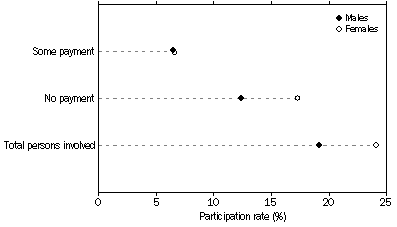
Age
Involvement in culture and leisure activities was lowest in the oldest age group, with 15% of those aged 65 years and over participating. In comparison, the participation rate for those aged 15 to 24 years was 25%, and for those aged 25 to 34 years was 23%. (Table 2)
PARTICIPATION RATE, By age
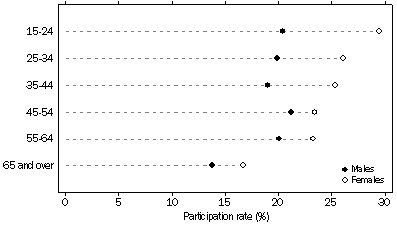
The proportion of people with paid involvement in culture and leisure activities was highest for those aged 25 to 34 years (9%), 35 to 44 years (8%) and 45 to 54 years (8%). Unpaid involvement only was highest for persons aged 15 to 24 years (19%). (Table 2)
Birthplace
Persons born in Australia had a participation rate of 23%, compared with 18% for persons born overseas. Persons born overseas in main English speaking countries had a similar rate (25%) to that for those born in Australia, while those born overseas from other than main English speaking countries had a participation rate of 14%. Of those born in Australia, 7% received some payment for working in a culture or leisure activity, compared with 5% for those born overseas. (Table 2)
Geographic location
The participation rates for the states and territories ranged from 21% for New South Wales to 30% for the Australian Capital Territory. (Table 1)
The participation rate for residents in the state capital cities (21%) was similar to that for residents outside the state capital cities (22%). However, there was a difference in rates for paid and unpaid involvement, with 7% of persons in the state capital cities reporting a paid involvement compared with 5% for those outside the state capital cities. Persons outside the state capital cities had a higher rate of unpaid only involvement - 17% compared with 14% for persons in the state capital cities. (Table 2)
PARTICIPATION RATE, By state or territory
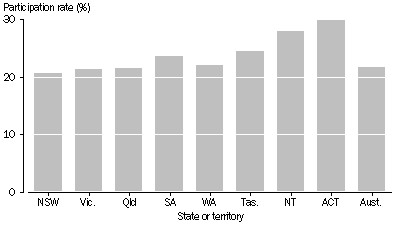
The participation rate increased since 2004 for all the states and territories except the Australian Capital Territory. The largest increase was observed in the Northern Territory (57%) followed by Tasmania (37%). (Table 14)
Labour force status
Of persons who were employed in the week prior to interview, 24% (or 2.5 million persons) were involved in a culture or leisure activity at some time during the 12 months prior to interview. Unemployed persons and those not in the labour force had participation rates of 21% (100,700 persons) and 17% (928,200 persons), respectively. Persons employed part-time (28%) had a higher participation rate than persons employed full-time (23%). (Table 2)
TYPE OF ACTIVITIES
Information was collected for a variety of culture and leisure activities in this survey (see the Glossary for a full list of activities).
Some 1.4 million persons had an involvement in visual art activities in the previous 12 months. This represents an increase of 79% from 2004 when there were 789,900 persons reporting an involvement in visual art activities. (Table 13)
In 2007, large numbers of persons reported involvement in the following visual art activities:
638,600 in photography (300,100 in 2004)
558,000 in drawing (288,700 in 2004)
552,500 in creating artworks with a computer (286,300 in 2004)
463,000 in painting (262,400 in 2004). (Table 13)
In 2007, there were 960,800 persons (or 27% of all persons involved) who had an involvement in craft activities. In comparison, there were 542,700 persons (or 20% of all persons involved) who reported an involvement in craft activities in 2004. The craft activities attracting large numbers of participants in 2007 were furniture-making and wood crafts (316,800 persons, up from 204,500 in 2004) and textiles (282,400 persons, up from 144,300 in 2004). (Table13)
Other activities with large numbers of persons involved in 2007 were:
506,300 in performing arts, an increase of 19% from 2004
459,200 in design, an increase of 24% from 2004
409,800 in festival organising, an increase of 62% from 2004
335,100 in music, with no statistically significant change from 2004
606,500 in writing, with no statistically significant change from 2004. (Table 13)
Patterns of involvement in particular culture and leisure activities were quite different for males and females. During 2007, there were more males than females involved in furniture-making and wood crafts (266,000 males compared with 50,800 females), designing websites (165,000 and 89,200), and designing computer games and other interactive software (62,600 and 12,800). Females outnumbered males by more than two to one for the activities of art and craft show organising (149,600 females compared with 50,300 males), performing arts (345,000 and 161,200), painting (335,300 and 127,700) and library and archive involvements (78,200 and 30,300). A noticeably higher number of females than males were also involved in craft activities (628,800 females compared with 332,100 males) and cultural teaching activities (154,800 and 101,900), which excludes primary and secondary school teaching. (Table 3)
PERSONS INVOLVED, In 5 most popular activities, By sex
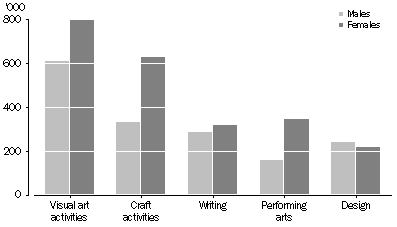
NATURE OF INVOLVEMENT
Payment status
More people had some paid involvement in visual art activities (281,900), design (279,800) and writing (240,700) than any other culture or leisure activity in the survey (note: paid involvement also includes persons who received goods and services as payment). Cinema and video distribution (64%) was among the activities with the highest proportion of persons involved receiving payment, along with zoos and aquaria (62%), design (61%), and television (56%). (Table 4)
Of the 1.1 million persons who received some payment, 39% were paid less than $5,000 over the year, 26% were paid between $5,000 and $39,999 and 24% were paid $40,000 or more. (Table 8)
The proportion of people being paid for their involvement has decreased from 35% in 2004 to 30% in 2007. (Table 14)
PARTICIPATION RATE 2004 and 2007, By payment status
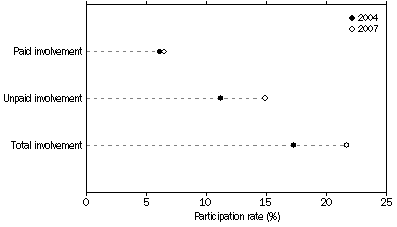
Duration of activities
Most people involved in culture and leisure activities had only a short-term involvement (up to 13 weeks of the year) or were involved for less than 10 hours per week over the 12 month period. For all activities except architecture, the majority of persons were involved for less than 10 hours per week. The activities with the highest proportion of persons involved for less than 10 hours per week were photography (91%), jewellery making (88%), painting (87%), and drawing (87%). (Table 9)
The activities that were most likely to be short-term were festival organising (81%), art and craft show organising (81%), national parks and reserves (72%) and television (72%). Architecture was one activity which tended to have involvements of a longer duration. Around 67% of persons involved in architecture did so for 10 hours or more per week and 69% of persons involved in architecture did so for more than 13 weeks of the year. (Table 9)
Income from activities
Annual income from culture and leisure activities was reasonably low because most people involved in culture and leisure activities had only a short-term or part-time involvement. For example, of the 118,800 persons with paid involvement in music, almost two-thirds (74,600 or 63%) received an annual income from this activity of less than $5,000. Conversely, 22,500 (63%) persons received an annual income of $5,000 or more from their paid involvement in libraries and archives. (Table 7)
Involvement as part of main job
Of the 1.1 million persons who received some payment for their involvement in culture and leisure activities, 66% (701,800 persons) stated their involvement was part of their main job they held last week. The activities with the highest proportion of persons where the activity was part of their main job held last week, were museums (8,400 persons or 86%), pottery and ceramics (14,400 or 85%), designing computer games and other interactive software (33,500 or 84%) and print-making (21,800 or 84%). (Table 6)
QUALIFICATIONS
People involved in selected activities (visual art, craft, writing, publishing, performing arts, music, designing websites, designing computer games and design) were asked whether they had qualifications relevant to these activities. Of the 3.1 million persons involved in these activities, 30% had relevant qualifications. The most commonly reported areas where persons had relevant qualifications were design (185,800) and writing (150,200), while fewer persons had relevant qualifications for activities such as glass crafts (8,800) and pottery and ceramics (20,200). Higher proportions of persons who had relevant qualifications were paid for their involvement (53%) than those without relevant qualifications (22%). (Table 11)
HOBBIES
Activities which were undertaken solely for the person's own use or for the use of their family or friends were classified as hobby activities. For this survey, data on hobby activities were only collected for art and craft, writing and music.
Around 2.0 million persons had a work involvement in arts and crafts, 606,500 had a work involvement in writing, and 335,100 in music. These figures include persons with both a work and hobby activity involvement. In addition, there were 2.1 million persons who were involved in art and craft as a hobby activity only, 356,900 persons were involved in writing as a hobby activity only, and 265,000 persons were involved in music as a hobby activity only. (Table 12)
 Print Page
Print Page
 Print All
Print All